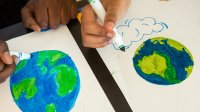Taking an Interdisciplinary Approach to Environmental Science
Teachers in any content area can use project-based learning to explore environmental concerns with their students.
In our work with schools, we’ve met many content area and elective teachers with an interest to learn more about environmental science (ES) because they love and care about the environment. They also want to pass this passion and know-how along to their students while not straying too far from their own instructional focus.
For example, an English language arts teacher may set up a project that has students advocate by writing letters to their local politicians offering solutions to environmental problems in their community. A social studies teacher may help students understand the legislative process through exploring landmark environmental laws or learning how state and federal governments work together to address issues affecting ecosystems in different parts of the United States.
Therefore, when we began writing our book, Environmental Science for Grades 6–12: A Project-Based Approach to Solving the Earth’s Most Urgent Problems, we set out to create a resource that both the ES and non-ES teacher could use to adapt projects that show the interdisciplinary nature of ES and at the same time appeal to diverse students.
For teachers wanting to try their hand at ES, we recommend having a solid understanding of the purpose of environmental education, which is to explore issues affecting the environment and work on solutions, while engaging students in projects where they learn about conservation, create calls to action, work with others, and solve environmental issues in their communities.
When planning learning experiences for students, we suggest that teachers select a relevant ES theme for their students, along with organizing student learning using three helpful frameworks:
1. Next Generation Science Standards (NGSS): A nationally adopted framework for science education that includes content standards and also highlights scientific practices as well as cross-cutting concepts that connect all four domains of science.
2. Collaborative for Academic Social and Emotional Learning (CASEL) Integrated Framework for SEL: This framework for social and emotional learning helps students better understand themselves, their environment, and others by dividing knowledge, skills, and attitudes into five domains.
3. International Society for Technology in Education (ISTE) Standards for Students: These standards ensure that their lessons and units are focused on student empowerment by helping teachers design learning experiences to build the skills necessary for thriving in a digital world.
Teachers can align with the three learning frameworks by developing well-crafted learning goals for ES projects organized around a theme that helps students solve critical environmental problems. Here’s how in two simple steps.
1. Select a Good Project Theme
A couple of good themes that provide powerful focal points to start with are projects involving ecosystems/ecology, or understanding the interactions between communities of organisms and their physical surroundings, and those that examine human impact on the environment and ways in which harms can be mitigated or prevented.
Ecosystems: Two foundational principles of ES are understanding the form and function of ecosystems and communicating complex scientific ideas in simple ways. Addressing these basics in a project on ecosystems and communication can build a strong foundation for more complex investigations in ES later. One great opportunity for combining these two concepts is through projects focused on investigating why some species are endangered, the factors that limit or disrupt the ecosystem services that may be at play, and what can be done to inspire others to advocate for positive changes. ELA teachers can help students craft a compelling call to action that can assist them in understanding how communication is key to advocacy and engaging others.
Human impact: The role of government in enforcing environmental laws connects to social studies. Scientific illustrations or the design of informative and eye-catching infographics connect to the visual arts. And the process of managing natural resources and balancing the needs of our own society with those of other communities, both human and natural, creates opportunities in all sorts of other academic disciplines.
One concept that provides a gateway into many other subjects is biodiversity. Students can use math to calculate the rate of Atlantic cod depletion while they develop their reading skills through analyzing excerpts of Mark Kurlansky’s book Cod. Students from more urban settings might find greater authenticity analyzing publicly available data on the biodiversity of wildlife within their city parks, then creating infographics that display the predator-prey relationships that allow these populations to remain stable. Using this knowledge, they can either write persuasive pieces arguing for stronger action to protect fish populations or use multimedia technology tools and fine arts skills to create short-form infomercials.
2. Utilize Technology and SEL Skills
Both ecosystems and human impact can connect to the abovementioned learning frameworks in numerous ways. Through pointed scientific investigation, students have the opportunity to discover that environmental learning doesn’t have to be relegated only to science class. Here are some tips for teachers to consider when crafting their learning goals via learning targets.
With standards framed around human sustainability and managing natural resources, NGSS is a natural fit with ES. To complement the NGSS, teachers can use the ISTE Standards for Students to help learners integrate the appropriate use of edtech across projects. It’s also important to understand that the ISTE standards are not just about using technology to augment instruction—they were intentionally written to align with academic subjects. And now that computers and apps are part of everything we do, the standards are beneficial in helping learners to become global collaborators who can leverage technology to solve ES problems innovatively.
There is growing research to support the relationship between the causes and effects of experiences in nature and how they can contribute to children’s learning and their social and emotional well-being. The self-awareness competency in the CASEL integrated framework is an excellent vehicle for helping students understand their emotional responses and thereby strengthen their emotional intelligence skills. For this purpose, ES projects can be instrumental as they navigate their emotional intelligence journey.
